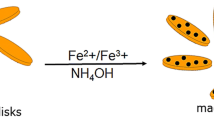Abstract
Thermo switchable magnetic hydrogels undoubtedly have a great potential for medical applications since they can behave as smart carriers able to transport bioactive molecules to a chosen part of the body and release them on demand via magneto-thermal activation. We report on the ability to modify the lower critical solution temperature (LCST) of poly(N-isopropylacrylamide) (PNIPAM) on demand from 32 °C to LCST ≥37 °C. This was achieved by the absorption of controlled amounts of magnetite nanoparticles on the polymer chains. We show, through the effect on cell viability, that the resulting magnetic PNIPAM is able to trap and to release bio-active molecules, such as cell growth factors. The activities of the released bio molecule are tested on human umbilical vein endothelial cells culture. We demonstrate that the LCST of the magnetic PNIPAM can be reached remotely via inductive heating with an alternating magnetic field. This approach on magnetic PNIPAM clearly supports appealing applications in safe biomedicine.




Similar content being viewed by others
Explore related subjects
Discover the latest articles, news and stories from top researchers in related subjects.References
Rubio-Retama J, Zafeiropoulos NE, Serafinelli C, Rojas-Reyna R, Voit B, Lopez Cabarcos E, Stamm M. Synthesis and characterization of thermosensitive pnipam microgels covered with superparamagnetic ç-Fe2O3 nanoparticles. Langmuir. 2007;23:10280–5.
Dionigi C, Piñeiro Y, Riminucci A, Bañobre M, Rivas J, Dediu V. Regulating the thermal response of PNIPAM hydrogels by controlling the adsorption of magnetite nanoparticles. Appl Phys A. 2014;114:585–90.
Balasubramaniam S, Pothayee N, Lin Y, House M, Woodward RC, St. Pierre TG, Davis RM, Riffle JS. Poly(N-isopropylacrylamide)-coated superparamagnetic iron oxide nanoparticles: relaxometric and fluorescence behavior correlate totemperature-dependent aggregation. Chem Mater. 2011;23:3348–56.
Messing R, Frickel N, Belkoura L, Strey R, Rahn H, Odenbach S, Schmidt AM. Cobalt ferrite nanoparticles as multifunctional cross-linkers in PAAm ferrohydrogels. Macromolecules. 2011;44:2990–9.
Zhao X, Kim J, Cezar CA, Huebsch N, Lee K, Bouhadir K, Mooney DJ. Active scaffolds for on-demand drug and cell delivery. Proc Nat Acad Sci USA. 2011;108:67–72.
Luo B, Song X-J, Zhang F, Xia A, Yang W-L, Hu J-H, Wang C-C. Multi-functional thermosensitive composite microspheres with high magnetic susceptibility based on magnetite colloidal nanoparticle clusters. Langmuir. 2010;26:1674–9.
Hora D, Pollert E, Mackova H. Properties of magnetic poly(glycidyl methacrylate) and poly(N-isopropylacrylamide) microspheres. J Mater Sci. 2008;43:5845–50.
Pich A, Bhattacharya S, Lu Y, Boyko V, Adler H-JP. Temperature-sensitive hybrid microgels with magnetic properties. Langmuir. 2004;20:10706–11.
Schild HG. Poly(N-isopropipylacrylamide): experiments, theory and application. Prog Polym Sci. 1992;17:163–249.
Sun S, Hu J, Tang H, Wu PI. Chain collapse and revival thermodynamics of poly(N-isopropylacrylamide) hydrogel. J Phys Chem B. 2010;114:9761–70.
Mackova H, Hora D. Effects of the reaction parameters on the properties of thermosensitive poly(N-isopropylacrylamide) microspheres prepared by precipitation and dispersion polymerization. J Polym Sci Pol Chem. 2006;44:968–82.
Afrassiabi A, Hoffman AS, Cadwell LA. Effect of temperature on the release rate of biomolecules from thermally reversible hydrogels. J Membr Sci. 1987;33:1191.
Wua J-Y, Liua S-Q, Heng PW-S, Yanga Y-Y. Evaluating proteins release from, and their interactions with, thermosensitive poly(N-isopropylacrylamide) hydrogels. J Control Release. 2005;102:361–72.
Takegami K, Sano T, Wakabayashi H, Sonoda J, Yamazaki T, Morita S, Shibuya T, Uchida A. New ferromagnetic bone cement for local hyperthermia. Bioceramics. 1997;10:535.
Regmi R, Bhattarai SR, Sudakar C, Wani AS, Cunningham R, Vaishnava PP, Naik R, Oupickyb D, Lawes G. Hyperthermia controlled rapid drug release from thermosensitive magnetic microgels. J Mater Chem. 2010;20:6158–63.
Mornet S, Vasseur S, Grasset F, Duguet EJ. Magnetic nanoparticle design for medical diagnosis and therapy. Mat Chem. 2004;1:2161–75.
Arruebo ML, Fernández-Pacheco R, Ibarra R, Santamaría MJ. Magnetic nanoparticles for drug delivery. Nanotoday. 2007;2:22.
Purushotham S, Ramanujan RVJ. Modeling the performance of magnetic nanoparticles in multimodal cancer therapy. Appl Phys. 2010;107:114701.
Zadrazil A, Tokarova V, Stepanek F. Remotely triggered release from composite hydrogel sponges. Soft Matter. 2012;8:1811–6.
Au A, Polotsky A, Krzyminski KL, Gutowska A, Hungerford DS, Frondoza CG. Evaluation of thermoreversible polymers containing fibroblast growth factor 9 (FGF-9) for chondrocyte culture. J Biomed Mater Res. 2004;69A:367–72.
Schenck JF. Physical interactions of static magnetic fields with living tissues. Prog Biophys Mol Biol. 2005;87:185.
Babincova M, Altanerova V, Altaner C, Cicmanec P, Babinec P. In vivo heating of magnetic nanoparticles in alternating magnetic field. Med Phys. 2004;31:2219–21.
Babincova M, Cicmanec P, Altanerova V, Altaner C, Babinec P. AC-magnetic field controlled drug release from magnetoliposomes: design of a method for site-specific chemotherapy. Bioelectrochemistry. 2002;55:17–9.
Purushotham S, Ramanujan RV. Thermoresponsive magnetic composite nanomaterials for multimodal cancer therapy. Acta Biomater. 2010;6:502–10.
Piñeiro-Redondo Y, Bañobre-López M, Pardiñas-Blanco I, Goya G, López-Quintela MA, Rivas J. The influence of colloidal parameters on the specific power absorption of PAA-coated magnetite nanoparticles. Nanoscale Res Lett. 2011;6:383.
LopezPerez JA, LopezQuintela MA, Rivas MJ. Preparation of magnetic fluids with particles obtained in microemulsions. J IEEE Transactions Magnet. 1997;33:4359–62.
Hu X, Tong Z, Lyon LA. Synthesis and physicochemical properties of cationic microgels based on poly(N-isopropylmethacrylamide). Colloid Polym Sci. 2010;289:333–9.
Singh N, Lyon LA. Synthesis of multifunctional nanogels using a protected macromonomer approach. Colloid Polym Sci. 2008;286:1061–9.
Day DR, Jabaiah S, Jacobs RS, Little RD. Cyclodextrin formulation of the marine natural product pseudopterosin a uncovers optimal pharmacodynamics in proliferation studies of human umbilical vein endothelial cells. Marine Drugs. 2013;11:3258–71.
Author information
Authors and Affiliations
Corresponding author
Rights and permissions
About this article
Cite this article
Dionigi, C., Lungaro, L., Goranov, V. et al. Smart magnetic poly(N-isopropylacrylamide) to control the release of bio-active molecules. J Mater Sci: Mater Med 25, 2365–2371 (2014). https://doi.org/10.1007/s10856-014-5159-7
Received:
Accepted:
Published:
Issue Date:
DOI: https://doi.org/10.1007/s10856-014-5159-7




